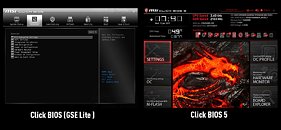Monday, July 8th 2019

BIOS ROM Size Limitations Almost Derail AMD's Zen2 Backwards Compatibility Promise
AMD succeeded in delivering on its backwards-compatibility promise for the 3rd generation Ryzen processors on motherboards based on AMD 300-series and 400-series chipsets. This promise was very close to being derailed suggests a community thread on MSI forums. According to MSI representatives active on the forum, the capacity of the SPI flash EEPROM chip that stores the motherboard UEFI firmware is woefully limited to cram in the AGESA ComboAM4 1.0.0.3a microcode on many of its motherboards.
The company had to make several changes to its UEFI BIOS package that's currently being circulated as a "beta," to accommodate support for 3rd generation Ryzen processors along with AGESA ComboAM4 1.0.0.3a. First, it had to kick out support for A-series and Athlon processors based on the 28 nm "Bristol Ridge" silicon. Second, it had to [and this is a big one], kick the RAID module, breaking SATA RAID on many of its motherboards. Third, it had to replace its feature-rich Click BIOS 5 setup program with a barebones "GSE Lite" Click BIOS program, which lacks many of the features of the original program, and comes with a dull, low-resolution UI. This program still includes some essential MSI-exclusive features such as A-XMP (which translates Intel XMP profiles to AMD-compatible settings), Smart Fan, and M-Flash.The scary part? Many other motherboard brands appear to be using 16-megabyte EEPROMs on their older socket AM4 motherboards. These companies are bound to run into similar ROM capacity issues unless they keep their UEFI setup programs lightweight. Motherboards based on the latest X570 chipset feature 32-megabyte EEPROMs. The AMD X570 chipset lacks support for not just "Bristol Ridge," but also first-generation Ryzen "Summit Ridge" and "Raven Ridge" processors.
We recommend that unless you literally possess a 3rd generation Ryzen processor, do not update the BIOS of your older socket AM4 motherboard. You may risk losing features and break your RAID volumes. Find out the latest version of BIOS that has the classic AGESA PinnaclePI 1.0.0.6 microcode, and use that instead.
Source:
MSI
The company had to make several changes to its UEFI BIOS package that's currently being circulated as a "beta," to accommodate support for 3rd generation Ryzen processors along with AGESA ComboAM4 1.0.0.3a. First, it had to kick out support for A-series and Athlon processors based on the 28 nm "Bristol Ridge" silicon. Second, it had to [and this is a big one], kick the RAID module, breaking SATA RAID on many of its motherboards. Third, it had to replace its feature-rich Click BIOS 5 setup program with a barebones "GSE Lite" Click BIOS program, which lacks many of the features of the original program, and comes with a dull, low-resolution UI. This program still includes some essential MSI-exclusive features such as A-XMP (which translates Intel XMP profiles to AMD-compatible settings), Smart Fan, and M-Flash.The scary part? Many other motherboard brands appear to be using 16-megabyte EEPROMs on their older socket AM4 motherboards. These companies are bound to run into similar ROM capacity issues unless they keep their UEFI setup programs lightweight. Motherboards based on the latest X570 chipset feature 32-megabyte EEPROMs. The AMD X570 chipset lacks support for not just "Bristol Ridge," but also first-generation Ryzen "Summit Ridge" and "Raven Ridge" processors.
We recommend that unless you literally possess a 3rd generation Ryzen processor, do not update the BIOS of your older socket AM4 motherboard. You may risk losing features and break your RAID volumes. Find out the latest version of BIOS that has the classic AGESA PinnaclePI 1.0.0.6 microcode, and use that instead.

88 Comments on BIOS ROM Size Limitations Almost Derail AMD's Zen2 Backwards Compatibility Promise
@evilhf Yes, should be good to go with 1.0.0.1. I sure hope so as I am running that on my TCU and should be popping in the 3900X tomorrow.
MSI has a BIOS update posted for my B350 Gaming Pro so you might want to check again for your board.
Good to know they promise a next one with RAID support.
I kinda like the non-stupid lite UI, I might just update to get that.
The Hardware Monitor Interface is sure plain looking now.
Edit: Ran into this issue involving Task Manger unable to report reserved memory. Technically there is 16,384 MB installed I can see 16,336 MB through Performance Monitor which means there is RAM being reserved by the mobo firmware. Before the update it use to report 47.7 MB inaccessible.
I planning to buy MSI b450 gaming pro carbon.
Should i buy this now?
In the end I have to say I hate AMD RAID. I've had it for many years as a convenience and an additional data protection method but it's a real pain in the ass when you have to migrate it. And nobody seems to support it out of the box. I had a motherboard with 780G chipset before. I could not migrate the VD from the old RAID to the new RAID, although they are both AMD. I had to backup all the data, create the RAID, copy the data back. Same now.
I bought a separate PCIe SATA controller with a Marvell chip and moved my disks there for RAID. Didn't have to install anything, it just worked. With AMD RAID I had to figure out that I needed two drivers to make it work, installed in a specific order, otherwise even Windows 10 won't see the disks. No live linux distro would ever boot with AMD RAID, all panicked. In a way I am glad I was forced out of using it. I don't know why they never bothered to make drivers easily available for all OSes.